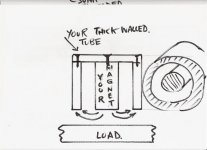Kevin Quitberg
Plastic
- Joined
- Oct 3, 2011
- Location
- Wyoming
I am trying to make some kind of enclosure for a neodymium magnet to orient the pulling force to one end of the magnet. I have made a sleeve of ductile iron to enclose the magnet circumferentially as well as on one end, leaving the end I want most of the magnetism on open. The magnet is supposed to lift in excess of 100 lbs. but I don't seem to be getting anywhere near that strength. It is an N52 rated magnet, .922" O.D. x 1" long.
So, some questions: Is a small hole in the magnet able to orient the pulling strength to the ends? Is there a better material to enclose the magnet with? Is there a minimum thickness of the jacketing material around the magnet? I have contacted some "magnet companies" but all their "engineers" live...guess where.
I am trying Practical Machinist on an off-topic question but it seems there is always an answer here for everything. Thanks in advance, KQ
So, some questions: Is a small hole in the magnet able to orient the pulling strength to the ends? Is there a better material to enclose the magnet with? Is there a minimum thickness of the jacketing material around the magnet? I have contacted some "magnet companies" but all their "engineers" live...guess where.
I am trying Practical Machinist on an off-topic question but it seems there is always an answer here for everything. Thanks in advance, KQ


